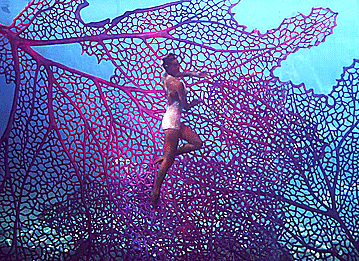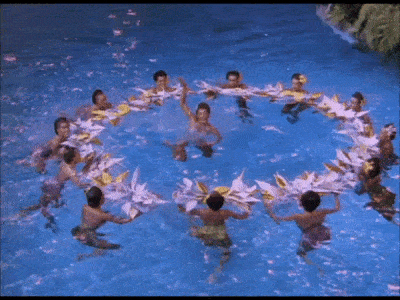Esther Williams, Godmother of Synchronized Swimming
The Olympics start tonight! I don’t know about you, but I love
the Olympics, and as someone who possesses zero athletic capabilities, something
about watching the best of the best competing on a global stage brings out the
sports fan in me.
Today, to celebrate, I want to focus on the Hollywood star who
has a long, tangled history with the Olympics, and who later became the godmother
to a sport.
I’m talking, of course, about Esther Williams, the godmother
of synchronized swimming.
You all know Esther Williams, the million dollar mermaid, the bonafide box office star throughout the ’40s and ‘50s, but you might not know her story.
Briefly, she was a swimming champ growing up. Set records,
won many competitions, and was all but guaranteed a spot on the US swimming
team for the 1940 Olympics.
But then the Second World War broke out and the Summer
Olympics were cancelled (in some alternate timeline they probably happened, as
planned, in Tokyo from September 21-October 6). They were cancelled again in
1944 (and would have been held in London), and by the time war was over and the
Olympics returned, Esther Williams was a Hollywood star.
And she’d helped create a sport. They called it water ballet
to begin with, and on screen, it was only Esther who was doing it.
She attributed her swimming style to working at Billy Rose’s
Aquacade at the Golden Gate International Exposition in California in 1940 because
she had to learn how to kick to keep her face, arms, and shoulders above the water,
and to move in balletic movements instead of the competitive moves she’d mastered
growing up.
In her autobiography, The Million Dollar Mermaid, Esther
wrote that she’d “come to appreciate that swimming with grace and beauty
could be as satisfying as swimming fast. I enjoyed developing the innovations that
became known as ‘synchronized swimming.’”
In her first starring movie, Bathing Beauty, which
came out in 1944, she basically choreographed the swimming routines herself
after the director told her to “Just do what you do, Esther.”
It took ten weeks to rehearse the routine for Bathing
Beauty, and Esther wrote that “many of the moves in the finale are the
basis of what we see today in state-of-the-art synchronized swimming at the
Olympics and elsewhere.”
After Bathing Beauty premiered, she noted that the
first synchronized swimming meet came a year later, in 1945.
One of Esther’s biggest goals in the second stage of her career was to get synchronized swimming recognized at the Olympic level. And one of the points of criteria was ensuring that there was an international level of competition with meets and teams.
“The creators of this international movement were the
coaches and parents who had been ‘my girls’—fans of my movies,” Esther
wrote. “They called me from all over the country saying, ‘We want to start a
water ballet group. How do we do it?’”
She and her mother started putting together packets for
clubs. Her mother, Bula, would study Esther’s films and question her about
various techniques; Esther would give detailed instructions that her mother
would transcribe.
Synchronized swimming was first held as a demonstration sport
at the 1952 Summer Olympics in Helsinki (Esther’s autobiography gives the erroneous
date of the 1956 Summer Olympics in Melbourne), which means that it wasn’t held
as part of the traditional medal categories, it was more about drawing
attention to the sport.
Esther attributes this to sexism and misogyny at the
International Olympic Committee level, saying that its then-President Avery
Brundage didn’t see how synchronized swimming was a sport: “They all just clones
of Esther Williams! That’s not a sport!”
Esther said: “Synchronized swimmers are superb athletes.
They have to learn ballet and first do their routines on dry land as exercises.
They have to hold their breath for long periods of strenuous activity. They
exercise with weights and pulleys to strengthen their arms for underwater work.
When they come out of the water, they look just as I looked in the movies:
sparkling and beautiful in their sequined swimsuits, with bright lipstick and
pretty hair.”
Brundage died in 1975, and, as Esther wrote, “a new
Olympic sport was born” in time for the 1984 Summer Olympics.
According to the Olympics website, “Artistic swimming
routines consist of a variety of moves including 'figures' (leg movements), arm
sections, and lifts (also known as highlights). Swimmers must not touch the
bottom of the pool and scull or use advanced methods of treading water to avoid
doing so. They must also not be out of the water for more than 10 seconds.
“There are two types of routines - free routines and
technical routines where a number of specified elements must be performed.”
Since its creation, the American, Canadian, and Russian
teams have been the only gold medal winners, with Russia winning every year
since 2000.
Synchronized swimming was renamed in 2017 to Artistic
Swimming. Today, there are duets and team events: duets for two swimmers and team
events for eight swimmers. In 1984, 1988 and 1992, there was a solo event, but
it was retired and the team event was introduced in 1996.
It’s interesting to note that this was only one of two
sports that was only open to women (the other being rhythmic gymnastics); but beginning
in Paris, two men maximum will be allowed to join the team competition.
In 1984, NBC—who has covered the Olympics for the United States
since time immemorial—hired Esther to do colour commentary for the Olympics in
Los Angeles. Here's a short video of Esther at the Olympics, though be warned, the audio quality is horrendous:
I’ll let Esther tell the story herself, about what it meant
to see synchronized swimming at the McDonald’s Olympic Swim Stadium: “I was
dazzled by the skill of all the athletes and by the underwater technology of
NBC’s coverage. Some of those girls were underwater for more than half of their
five-minute programs and you could see every balletic move.”
And of the swimmers, she wrote: “I was touched to realize
how these girls had seen those movies and gotten together in their little
groups and wanted to swim pretty and not fast. They created a sport and went
all over the world to teach it and sell it. I was proud to be there when it
came into the Olympics. I was proud to be an inspiration, a godmother to a
sport. It was a very emotional moment for me. Tears came to my eyes on camera,
and I thought, I love every one of those girls in the water.”
It's important to note the contribution of other female
swimmers who helped create the sport; it wasn’t only Esther.
If you factor in the name and the regulations and the push
to get synchronized swimming to the Olympic level, you have to recognize
Katherine Whitney Curtis, who started developing the sport in the ‘30s.
Her career was interrupted by the war, but afterwards she
travelled the world developing synchronized swimming, but died in 1980 before she
could see it officially become an Olympic sport.
Other important women in the history of synchronized swimming include Annette Kellerman (who Esther portrayed in Million Dollar Mermaid), Beulah Gundling, and Gail Johnson, though these are by no means the only women involved. I’d definitely recommend looking up the history of this sport, it’s pretty fascinating.





I share your fondness for the Olympics -- I've been into them since I was a little girl -- and I greatly enjoyed this post, Jess! I learned so much! Also, I have such an appreciation for artistic swimming (which, I did not know, had been renamed). When I read that the men will be competing, I couldn't help but remember the hilarious SNL skit with Christopher Guest and Martin Short -- have you seen it?
ReplyDelete